Related Research Articles
"Norwegian Wood (This Bird Has Flown)" otherwise known as simply "Norwegian Wood", is a song by the English rock band the Beatles from their 1965 album Rubber Soul. It was written mainly by John Lennon, with lyrical contributions from Paul McCartney, and credited to the Lennon–McCartney songwriting partnership. Influenced by the introspective lyrics of Bob Dylan, the song is considered a milestone in the Beatles' development as songwriters. The track features a sitar part, played by lead guitarist George Harrison, that marked the first appearance of the Indian string instrument on a Western rock recording. The song was a number 1 hit in Australia when released on a single there in 1966, coupled with "Nowhere Man".
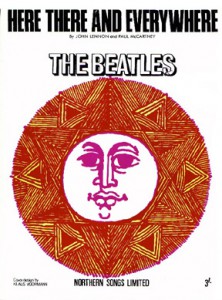
"Here, There and Everywhere" is a song by the English rock band the Beatles from their 1966 album Revolver. A love ballad, it was written by Paul McCartney and credited to Lennon–McCartney. McCartney includes it among his personal favourites of the songs he has written. In 2000, Mojo ranked it 4th in the magazine's list of the greatest songs of all time.

"Think for Yourself" is a song by the English rock band the Beatles from their 1965 album Rubber Soul. It was written by George Harrison, the band's lead guitarist, and, together with "If I Needed Someone", marked the start of his emergence as a songwriter beside John Lennon and Paul McCartney. The song's lyrics advocate independent thinking and reflect the Beatles' move towards more sophisticated concepts in their writing at this stage of their career. The song has invited interpretation as both a political statement and a love song, as Harrison dismisses a lover or friend in a tone that some commentators liken to Bob Dylan's 1965 single "Positively 4th Street". Among musicologists, the composition has been recognised as adventurous in the degree of tonal ambiguity it employs across parallel major and minor keys and through its suggestion of multiple musical modes.
"Because" is a song written by John Lennon and recorded by the English rock band the Beatles. It was released on their 1969 album Abbey Road, immediately preceding the extended medley on side two of the record. It features a prominent three-part vocal harmony by Lennon, Paul McCartney and George Harrison, recorded three times to make nine voices in all.
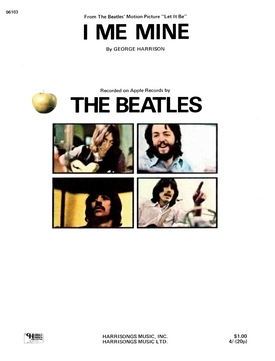
"I Me Mine" is a song by the English rock band the Beatles from their 1970 album Let It Be. Written by George Harrison, it was the last new track the group recorded before their break-up in April 1970. The song originated from their January 1969 rehearsals at Twickenham Film Studios when they were considering making a return to live performance. Written at a time of acrimony within the group, the lyrics lament humankind's propensity for self-centredness and serve as a comment on the discord that led to Harrison temporarily leaving the Beatles. The musical arrangement alternates between waltz-time verses and choruses played in the hard rock style.
"The End" is a song by the English rock band the Beatles from their 1969 album Abbey Road. It was composed by Paul McCartney and credited to Lennon–McCartney. It was the last song recorded collectively by all four Beatles, and is the final song of the medley that constitutes the majority of side two of the album. The song features the only drum solo recorded by Ringo Starr with the Beatles.
"Across the Universe" is a song by the English rock band the Beatles. It was written by John Lennon and credited to Lennon–McCartney. The song first appeared on the 1969 various artists' charity compilation album No One's Gonna Change Our World and later, in a different form, on their 1970 album Let It Be, the group's final released studio album. The original version featured on two different albums both titled Rarities: a 1978 British release and a 1980 US release. It was also included on their 1988 album Past Masters, Volume Two. The song has been covered by many artists, including David Bowie on his 1975 album Young Americans, which featured contributions from Lennon.
"You Know My Name (Look Up the Number)" is a song by the English rock band the Beatles released initially as the B-side of the single "Let It Be" on 6 March 1970. Although first issued with their final single (and the penultimate single in the United States), the Beatles recorded the song in four separate sessions, beginning with three in May and June 1967, shortly after completing their album Sgt. Pepper's Lonely Hearts Club Band, with one final recording session conducted in April 1969. The song features a saxophone part played by Brian Jones of the Rolling Stones.
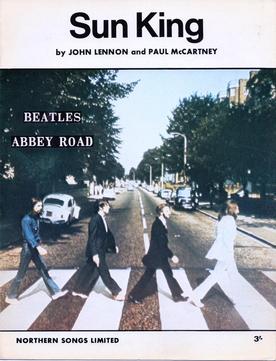
"Sun King" is a song by the English rock band the Beatles from their 1969 album Abbey Road. Written primarily by John Lennon and credited to Lennon–McCartney, it is the second song of the album's climactic medley. Like other tracks on the album the song features lush multi-tracked vocal harmonies, provided by Lennon, Paul McCartney and George Harrison.
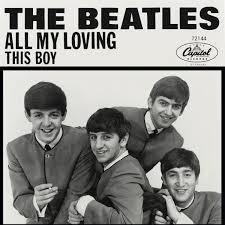
"This Boy" is a song by the English rock band the Beatles, written by John Lennon (credited to Lennon–McCartney). It was released in November 1963 as the B-side of the band's Parlophone single "I Want to Hold Your Hand". In the United States, it was issued in January 1964 on Meet the Beatles! which was Capitol Records' reconfigured version of the With the Beatles album. The Beatles performed the song live on 16 February 1964 for their second appearance on The Ed Sullivan Show. An instrumental easy listening arrangement by George Martin, re-titled "Ringo's Theme (This Boy)", was featured in the film A Hard Day's Night and the United Artists soundtrack album. This version was also issued as a single, reaching number 53 in the US and number one in Canada.
"Fixing a Hole" is a song by the English rock band the Beatles from their 1967 album Sgt. Pepper's Lonely Hearts Club Band. It was written by Paul McCartney and credited to Lennon–McCartney.

"I Want to Tell You" is a song by the English rock band the Beatles from their 1966 album Revolver. It was written and sung by George Harrison, the band's lead guitarist. After "Taxman" and "Love You To", it was the third Harrison composition recorded for Revolver. Its inclusion on the LP marked the first time that he was allocated more than two songs on a Beatles album, a reflection of his continued growth as a songwriter beside John Lennon and Paul McCartney.
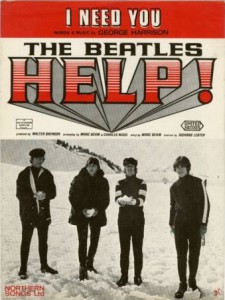
"I Need You" is a song by the English rock band the Beatles from their 1965 album Help! It was written by George Harrison, the group's lead guitarist, and was the second composition of his to be released by the Beatles. The track appears in their film Help!, in a scene filmed on Salisbury Plain where the group were under military protection from a murderous cult.
"You Like Me Too Much" is a song by the English rock band the Beatles. It was written by George Harrison, the group's lead guitarist, and released in August 1965 on the Help! album, except in North America, where it appeared on Beatles VI. The band recorded the track on 17 February that year at EMI Studios in London.

"All My Loving" is a song by the English rock band the Beatles, from their second UK album With the Beatles (1963). It was written by Paul McCartney, and produced by George Martin. Though not officially released as a single in the United Kingdom or the United States, the song drew considerable radio airplay, prompting EMI to issue it as the title track of an EP. The song was released as a single in Canada, where it became a number one hit. The Canadian single was imported into the US in enough quantities to peak at number 45 on the US Billboard Hot 100 in April 1964.
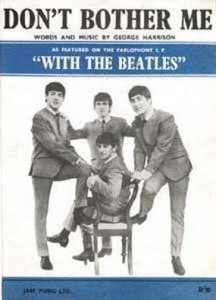
"Don't Bother Me" is a song by the English rock band the Beatles from their 1963 UK album With the Beatles. It was the first song written by George Harrison, the group's lead guitarist, to appear on one of their albums. A midtempo rock and roll song, it was originally released in the United States on the 1964 album Meet the Beatles!

"Not a Second Time" is a song by English rock band the Beatles. It was written by John Lennon, though credited to the Lennon–McCartney partnership. It was first released on the Beatles second British album, With the Beatles, and their second American album Meet the Beatles!. Lennon said he was "trying to write a Smokey Robinson or something at the time." The song was recorded in nine takes on 11 September 1963 at EMI Studios.

"Old Brown Shoe" is a song by the English rock band the Beatles. Written by George Harrison, the group's lead guitarist, it was released on a non-album single in May 1969, as the B-side to "The Ballad of John and Yoko". The song was subsequently included on the band's compilation albums Hey Jude, 1967–1970 and Past Masters, Volume Two. Although "Old Brown Shoe" remains a relatively obscure song in the band's catalogue, several music critics view it as one of Harrison's best compositions from the Beatles era and especially admire his guitar solo on the track.

"Yes It Is" is a song by the English rock band the Beatles. Written by John Lennon, it was first released in 1965 as the B-side to "Ticket to Ride". It features some of the Beatles' most complex and dissonant three-part vocal harmonies and showcases George Harrison's early use of volume pedal guitar. Ian MacDonald describes the song as having "rich and unusual harmonic motion."

"In Spite of All the Danger" is the first song recorded by the Quarrymen, then consisting of John Lennon, Paul McCartney, George Harrison, pianist John Lowe, and drummer Colin Hanton.
References
- 1 2 Lewisohn 1988, p. 45.
- 1 2 Lewisohn 1995, pp. 40–41.
- ↑ Lewisohn 1988, pp. 35–36.
- ↑ Lewisohn 1988, p. 54.
- ↑ Unterberger 2006, p. 96.
- ↑ Pedler, Dominic (2003). Songwriting Secrets of the Beatles. Omnibus Press. pp. 39–40. ISBN 9780857123466.
- ↑ Dominic Pedler. Songwriting Secrets of the Beatles. Omnibus Press. 2003. pp311-314
- ↑ Harry, Bill (2003). The George Harrison Encyclopedia. London: Virgin Books. p. 396. ISBN 978-0-7535-0822-0.
- ↑ https://ultimateclassicrock.com/every-beatles-song/ All 227 Beatles Songs Ranked Worst to Best
- Lewisohn, Mark (1995). Anthology 1 (CD Booklet). The Beatles. Apple Corps Ltd. 7243-8-34445-2-6.
- Lewisohn, Mark (1988). The Beatles Recording Sessions: The Official Abbey Road Studio Session Notes 1962-1970 . Great Britain: Hamlyn. ISBN 0-600-55784-7.
- Unterberger, Ritchie (2006). The Unreleased Beatles: Music and Film. San Francisco: Backbeat Books. ISBN 0-87930-892-3.